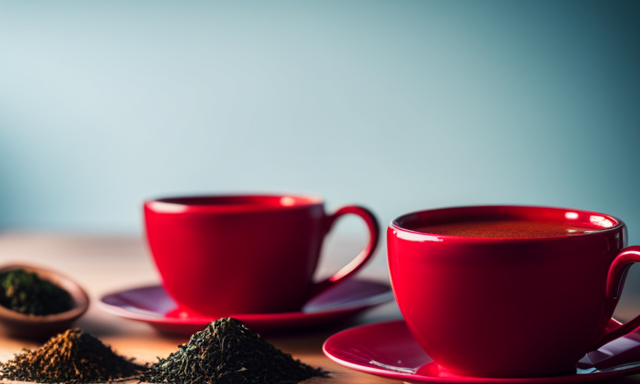As I sit here, sipping on a warm cup of rooibos tea, I can’t help but marvel at its unique flavor and soothing properties. It’s amazing how something so simple can bring such immense pleasure.
If you’re like me and have fallen in love with this South African herbal infusion, then you’re in for a treat. In this article, I will guide you through the art of serving rooibos tea, from understanding the different types and selecting the perfect blend to brewing it to perfection and enhancing its natural flavors.
We’ll also explore the versatility of rooibos tea in cocktails, mocktails, and food pairings. And don’t worry, I’ll share some tips on storing and preserving this precious beverage as well.
So, whether you’re a long-time fan or a curious beginner, get ready to embark on a journey into the wonderful world of rooibos tea.
Key Takeaways
- Rooibos tea can be served hot or iced, offering versatility in how it can be enjoyed.
- Consider personal taste preferences and desired flavor intensity when choosing a type of rooibos tea.
- Enhance the flavor of rooibos tea with additions like lemon, mint, cinnamon sticks, or orange zest.
- When serving hot rooibos tea, consider a traditional tea ceremony for a mindful experience, and pair with biscuits or pastries for a delightful tea-time treat.
Understanding Rooibos Tea
Rooibos tea, with its vibrant red color and earthy aroma, is a delicious and caffeine-free alternative to traditional teas.
There are different types of rooibos tea available, such as green rooibos, which is unfermented and has a milder taste, and red rooibos, which has a stronger flavor. Both types offer numerous health benefits, including being rich in antioxidants, supporting immune function, and promoting heart health.
Rooibos tea is also known for its anti-inflammatory properties and its ability to improve digestion.
To choose the right rooibos tea, consider your personal taste preferences and the desired intensity of flavor. Whether you prefer a delicate cup of green rooibos or a robust mug of red rooibos, this versatile tea is sure to satisfy your cravings without the jolt of caffeine.
Choosing the Right Rooibos Tea
When it comes to choosing the right Rooibos tea, there are a few key points to consider.
First, the different varieties and flavors of Rooibos tea offer a wide range of options to suit individual preferences. From fruity and floral blends to more traditional and earthy flavors, there is something for everyone.
Additionally, for those who prioritize sustainability and ethical practices, there are organic and fair trade options available, ensuring that your tea is not only delicious but also sourced responsibly.
Different Varieties and Flavors of Rooibos Tea
One interesting statistic is that there are over 40 different flavors and varieties of rooibos tea available. It’s truly a tea lover’s paradise! When it comes to brewing rooibos tea, there are different methods to choose from. You can steep it in hot water or simmer it on the stove. Both methods result in a rich and flavorful cup of tea.
Now, let’s dive into the exciting world of rooibos tea flavors. Here are three tantalizing options that will surely grab your attention:
- Vanilla Rooibos: Indulge in the smooth and creamy taste of vanilla infused with the earthy notes of rooibos.
- Berry Burst Rooibos: Experience a burst of fruity flavors with the infusion of berries like strawberries, raspberries, and blueberries.
- Spiced Chai Rooibos: Enjoy the warmth and spice of traditional chai blended with the delicate sweetness of rooibos.
With so many varieties to choose from, you can always find a rooibos tea that suits your taste buds and preferences. And now, let’s explore the world of organic and fair trade options without missing a beat.
Organic and Fair Trade Options
Get ready to make a socially and environmentally conscious choice with these organic and fair trade options that’ll leave you feeling good about your tea selection.
When it comes to rooibos tea, you can find varieties that are certified organic, ensuring they’re free from synthetic pesticides and chemicals. Look for teas that have the organic certification label to guarantee their purity.
Additionally, many companies offer fair trade rooibos tea, which means the tea is sourced ethically and supports the livelihoods of farmers and workers. By choosing these options, you can enjoy your cup of rooibos tea knowing it was produced in a way that promotes sustainability and fair wages.
Now let’s move on to properly brewing rooibos tea.
Properly Brewing Rooibos Tea
To brew a delicious cup of rooibos tea, start by steeping the vibrant red leaves in freshly boiled water, allowing their earthy aroma to fill your senses and transport you to the tranquil fields of South Africa.
Here are five key tips to properly brewing rooibos tea:
- Use a temperature of 200°F (93°C) to bring out the best flavors.
- Steep the tea for 5-7 minutes to fully extract its rich flavor.
- For a stronger taste, increase the amount of tea leaves.
- To enhance the aroma, add a slice of lemon or a sprig of mint.
- Enjoy the health benefits of rooibos tea, which include its high antioxidant content and potential to improve digestion.
By following these steps, you’ll have a perfectly brewed cup of rooibos tea that’s both aromatic and packed with health benefits.
Moving on to enhancing the flavor of rooibos tea, let’s explore some exciting additions and combinations.
Enhancing the Flavor of Rooibos Tea
Indulge your senses with a medley of flavors that dance upon your taste buds as you explore the art of enhancing the natural beauty of rooibos tea. One way to enhance the flavor of rooibos tea is by adding aromatic ingredients such as cinnamon sticks or orange zest to the brew. These additions infuse the tea with a delightful aroma that complements the earthy notes of the rooibos.
Not only do these enhancements provide a sensory delight, but they also offer numerous health benefits. Rooibos tea is rich in antioxidants, which help to boost the immune system and reduce the risk of chronic diseases. By incorporating these aromatic ingredients, you not only enhance the flavor but also increase the overall wellness benefits of your cup of rooibos tea.
Now, let’s move on to serving rooibos tea hot, where we’ll explore the best way to enjoy this comforting beverage.
Serving Rooibos Tea Hot
When serving Rooibos tea hot, there are a few key points to keep in mind. First, consider incorporating a traditional tea ceremony to enhance the experience. This can include brewing the tea in a teapot, using a tea strainer, and pouring the tea into delicate tea cups.
Additionally, pairing the hot Rooibos tea with biscuits or pastries can complement the flavors and create a delightful tea-time treat.
Traditional Tea Ceremony
During a traditional tea ceremony, one can experience a profound sense of tranquility while savoring the rich flavors of rooibos tea. The traditional tea ceremony holds great cultural significance, as it embodies the art of mindfulness and appreciation for the present moment.
The ceremony often involves carefully preparing and presenting the tea, using specific utensils and gestures that have been passed down through generations. As the tea is steeped and poured into delicate cups, the earthy aroma of rooibos fills the air, creating an atmosphere of serenity and reflection.
The act of sipping the tea, with its distinct taste and warm embrace, further enhances the peaceful experience. As the traditional tea ceremony concludes, one can transition seamlessly into the next section, exploring the delightful pairing of rooibos tea with biscuits or pastries.
Pairing with Biscuits or Pastries
Immerse yourself in the harmony of flavors as you explore the enchanting pairing of warm biscuits or delicate pastries, elevating your experience with rooibos tea to a whole new level of culinary delight.
To create the perfect pairing, consider these biscuit recipes and tea party ideas:
-
Classic Buttermilk Biscuits: The buttery richness of these biscuits complements the earthy notes of rooibos tea.
-
Chai-Spiced Shortbread Cookies: Infused with warm spices like cinnamon and cardamom, these cookies enhance the aromatic qualities of rooibos tea.
-
Lemon Poppy Seed Scones: The zesty lemon flavor of these scones provides a refreshing contrast to the mellow sweetness of rooibos tea.
-
Almond Croissants: The flaky, nutty goodness of almond croissants pairs brilliantly with the smooth, caramel-like taste of rooibos tea.
Now, let’s explore the art of serving rooibos tea iced, and discover the refreshing possibilities that await.
Serving Rooibos Tea Iced
To enhance the sophistication of serving rooibos tea iced, a simple yet elegant method involves steeping the tea in cold water for an extended period of time. This process extracts the delicate flavors from the tea leaves, resulting in a refreshing and flavorful beverage.
Serving rooibos tea iced has numerous benefits, including its ability to cool you down on a hot day and its potential to aid digestion. The naturally sweet and nutty flavor of rooibos tea pairs perfectly with the cold infusion method, creating a truly enjoyable experience.
Once the tea is steeped and chilled, it can be served over ice for a crisp and revitalizing drink.
Transitioning into the subsequent section about rooibos tea cocktails and mocktails, this iced tea base serves as a versatile and delicious foundation for creating exciting and unique beverages.
Rooibos Tea Cocktails and Mocktails
I love experimenting with different flavors and ingredients to create unique tea-based alcoholic beverages. Adding a splash of rooibos tea to a cocktail can add a subtle earthy sweetness that pairs perfectly with other spirits and mixers.
On the other hand, if you prefer alcohol-free options, there are plenty of delicious mocktail recipes that showcase the flavors of rooibos tea in a refreshing and vibrant way.
Let’s dive into the world of rooibos tea cocktails and mocktails and discover some exciting recipes!
Creating Unique Tea-Based Alcoholic Beverages
Get creative and mix your favorite rooibos tea with a splash of vodka to create a one-of-a-kind tea-infused cocktail that will tantalize your taste buds. When it comes to tea-infused cocktails, the possibilities are endless. You can experiment with different flavors and ingredients to craft unique and creative tea-based libations. To give you some inspiration, here is a table showcasing four tea-infused cocktail recipes that are sure to impress your guests:
| Cocktail Name | Ingredients |
|---|---|
| Rooibos Martini | Rooibos tea, vodka, simple syrup |
| Spicy Chai Margarita | Chai tea, tequila, lime juice, agave syrup |
| Earl Grey Gin Fizz | Earl Grey tea, gin, lemon juice, simple syrup |
| Green Tea Mojito | Green tea, rum, mint leaves, lime juice, simple syrup |
Now that you have some ideas for tea-infused cocktails, let’s explore alcohol-free mocktail recipes that are perfect for those looking for a refreshing and non-alcoholic option.
Alcohol-Free Mocktail Recipes
Now that we’ve explored the exciting world of creating unique tea-based alcoholic beverages, let’s shift gears and dive into the realm of alcohol-free mocktail recipes.
Mocktails are a fantastic alternative for those who prefer to skip the alcohol but still crave a flavorful and refreshing drink. With a wide range of alcohol-free mocktail ingredients available, the possibilities are endless.
From fresh fruits and herbs to flavored syrups and sparkling water, you can create a mocktail that suits your taste perfectly. To make it even more enticing, consider getting creative with the presentation. Add garnishes like citrus twists, edible flowers, or colorful straws to make your mocktail visually appealing.
With these tantalizing options, you’ll never feel left out at social gatherings. Now, let’s explore the delightful world of pairing rooibos tea with food.
Pairing Rooibos Tea with Food
To enhance your culinary experience, consider pairing your rooibos tea with a delightful array of delectable dishes. Rooibos tea’s unique flavor profile makes it a versatile choice for pairing with various foods.
When it comes to meat, rooibos tea complements both poultry and red meat. The tea’s earthy and slightly sweet notes beautifully enhance the flavors of roasted chicken, grilled steak, or even lamb stew.
For cheese lovers, rooibos tea pairs well with both soft and hard cheeses. The tea’s natural sweetness balances the richness of creamy brie or sharp cheddar, creating a harmonious combination.
To further elevate your rooibos tea experience, experiment with pairing it with different types of meat and cheese to discover your own personal favorites.
Now, let’s delve into the fascinating world of storing and preserving rooibos tea.
Storing and Preserving Rooibos Tea
Ensure your rooibos tea remains fresh and flavorful by storing it in an airtight container away from direct sunlight and moisture. Proper storage techniques are essential for preserving the freshness of rooibos tea. Here are some tips to help you keep your tea at its best:
- Store your rooibos tea in an airtight container to prevent exposure to air, which can cause the tea to lose its flavor.
- Keep the container away from direct sunlight, as UV rays can degrade the tea and affect its taste.
- Avoid storing rooibos tea in humid areas, as moisture can cause the tea to become damp and lose its flavor.
By following these storage guidelines, you can ensure that your rooibos tea retains its freshness and flavor for a longer period of time.
Now, let’s explore the world of rooibos tea and discover its unique characteristics and benefits.
Exploring the World of Rooibos Tea
Immerse yourself in the vibrant world of rooibos tea, where each sip unlocks a treasure trove of flavors and benefits, like a kaleidoscope of wellness waiting to be discovered.
Rooibos tea originates from the Cederberg region of South Africa, where it’s been enjoyed for centuries. This unique herbal tea is known for its rich, earthy taste and its remarkable health benefits.
Rooibos tea is naturally caffeine-free, making it a perfect choice for those seeking a soothing and relaxing beverage. It’s also packed with antioxidants, which can help boost the immune system and protect against free radicals.
Additionally, rooibos tea has anti-inflammatory properties and may aid in digestion.
So, go ahead and explore the world of rooibos tea, and experience its origins and remarkable health benefits for yourself.
Frequently Asked Questions
How long does rooibos tea stay fresh after it has been brewed?
After brewing, rooibos tea can stay fresh for up to 24 hours if stored properly. To maintain its flavor and quality, it is recommended to store it in an airtight container in a cool, dark place away from moisture and strong odors.
Can I add milk or cream to my rooibos tea?
Sure, you can add milk or cream to your rooibos tea. However, if you’re looking for alternative ways to enhance the flavor, try adding a dash of honey or a squeeze of lemon.
Are there any potential health benefits of drinking rooibos tea?
Rooibos tea has potential health benefits supported by scientific research. It is rich in antioxidants, may improve heart health, and can help with digestion. However, there are no known potential health risks associated with drinking rooibos tea.
Can I reuse rooibos tea leaves to make a second batch of tea?
Yes, you can reuse rooibos tea leaves to brew a second batch. Simply steep the leaves in hot water for a few minutes longer than the first brew to extract the remaining flavor.
Are there any specific types of sweeteners that pair well with rooibos tea?
When it comes to pairing sweeteners with rooibos tea, there are various options to enhance its flavor. From honey and agave nectar to stevia and maple syrup, each sweetener brings a unique twist to your cup.
Conclusion
In conclusion, serving rooibos tea is a delightful journey into the world of flavors and aromas. It’s a gem worth exploring, with its unique taste and numerous health benefits. By understanding the different types of rooibos tea, brewing it properly, and enhancing its flavor, you can create a truly enjoyable tea experience.
Whether you prefer it hot or in a cocktail, rooibos tea offers a versatile beverage that can be enjoyed on its own or paired with delicious food. So go ahead, indulge in the wonders of rooibos tea and let your taste buds embark on a flavorful adventure.










